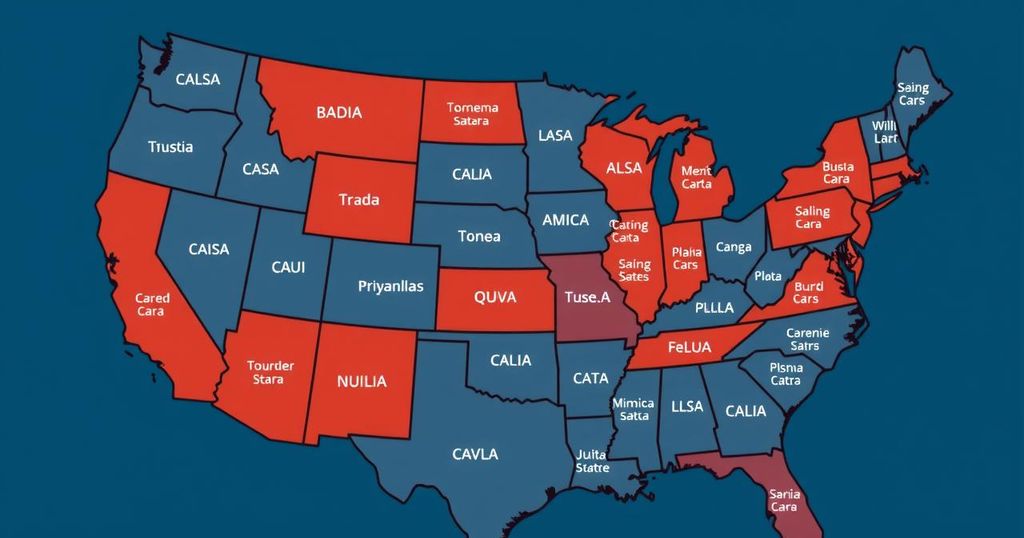In the final stages of the presidential race, Kamala Harris and Donald Trump are focusing their campaigns on Latino voters in swing states Arizona and Nevada. Polling indicates a competitive landscape, with Trump gaining support among Hispanics while Harris is experiencing a decline compared to Biden’s 2020 performance. Early voting trends show low Latino turnout, raising concerns about their electoral influence, and both candidates are addressing issues related to immigration and gender in their efforts to galvanize support.
In the lead-up to the November 5 presidential election, candidates Kamala Harris and Donald Trump are intensifying their focus on pivotal swing states, particularly Arizona and Nevada. These states, characterized by their substantial Latino populations, are viewed as critical for electoral success as both candidates vie for the crucial Latino vote. On a recent Thursday, both Harris and Trump conducted events in these states, as the election campaign reaches its climax amidst a neck-and-neck competition. Trump embarked on a detour to Albuquerque, New Mexico – a state he lost in the previous election by a significant margin – where he emphasized his affinity for the Hispanic community, stating, “I like you very much, and it’s good for my credentials with the Hispanic or Latino community.” This election cycle marks a notable shift in Latino voting trends; traditionally a Democratic stronghold, there has been a discernable movement towards the Republican side, with Trump reportedly garnering 42 percent of Hispanic support according to the latest polling. In contrast, Harris’s support among this demographic has dwindled to only 52 percent, a considerable decrease from the 66 percent that propelled President Joe Biden in the 2020 election. The candidates’ activities are further complicated by recent controversies, particularly surrounding Trump, who faced backlash following a comedian’s derogatory comments at one of his rallies. In response to this criticism, Trump declared his love for the Latino community, attempting to distance himself from the offensive remarks. The significance of early voting trends cannot be overstated, as Hispanic voter turnout has historically lagged behind other groups. Current data indicates that Latinos represent merely 2 percent of early votes cast, considerably lower than their proportion of eligible voters. Conversely, Black voters have demonstrated higher engagement, making up 22 percent of early voters. Gender dynamics are also at play, as women are showing stronger early voting rates than men, a trend that might benefit Harris, who has prioritized issues related to reproductive rights in her campaign. Trump, for his part, is banking on dissatisfaction with the Biden-Harris administration’s immigration policies to regain favor in Arizona – a state he lost previously. According to Republican political strategist Mike Madrid, the outcome of the election may hinge on which party effectively mobilizes their respective voting blocs, declaring, “Republicans are placing their hopes on young, US-born, Latino men while Democrats are banking on the defection of more college-educated, white, Republican women. Whoever is right will win the race.”
As the presidential election approaches, both major candidates are pivoting their campaigns to target Latino voters in swing states, with a particular focus on Arizona and Nevada. These states are seen as critical battlegrounds where the voter turnout of the Latino community could decisively influence the election outcome. Historical tendencies show that Latinos have predominantly supported Democratic candidates, yet recent polling suggests an increasing alignment with Republican candidates, particularly Trump, which is reshaping the electoral landscape. Furthermore, early voting patterns reveal concerns around voter engagement among Hispanic communities, which may impact their electoral influence significantly. Candid conversations surrounding immigration policies and gender dynamics are integral in shaping voter attitudes this election cycle, making the performance of both candidates in these areas crucial as they campaign in the final stretch.
In summary, Kamala Harris and Donald Trump are strategically mobilizing their efforts in crucial swing states, notably Arizona and Nevada, as they work to secure the vital Latino vote ahead of the upcoming presidential election. Polling indicates a narrowing race, with both candidates attempting to address shifting voter demographics and trends. Early voting data raises significant questions about Latino engagement, a factor that could prove decisive in determining the election outcome, particularly in the context of ongoing discussions around immigration and gender rights. The ultimate victor is likely to emerge from effectively capturing and mobilizing their core constituencies amidst this competitive landscape.
Original Source: www.aljazeera.com






